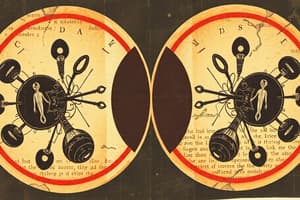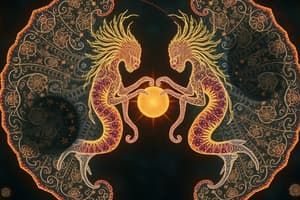Podcast
Questions and Answers
What is the definition of mitosis?
What is the definition of mitosis?
Cell division in which the nucleus divides into nuclei containing the same number of chromosomes. Two daughter cells identical to the parent. Takes 2 to 4 hours and is constant. Segregation of sister chromatids. Growth of the embryo and in somatic cells capable of cell division. Processes include prophase, metaphase, anaphase, telophase, and cytokinesis.
What is the definition of nondisjunction?
What is the definition of nondisjunction?
An error in meiosis or mitosis in which members of a pair of homologous chromosomes or a pair of sister chromatids fail to separate properly from each other.
What is meant by the cell cycle?
What is meant by the cell cycle?
The time from the birth of a new somatic cell until it divides into two new daughter cells.
What is interphase in the cell cycle?
What is interphase in the cell cycle?
What is the spindle assembly checkpoint?
What is the spindle assembly checkpoint?
What is the G1 checkpoint?
What is the G1 checkpoint?
What happens during the G0 phase?
What happens during the G0 phase?
What does the G2 checkpoint check for?
What does the G2 checkpoint check for?
What is the correct order of the interphase stages?
What is the correct order of the interphase stages?
What is the G1 phase?
What is the G1 phase?
What occurs during the S phase of interphase?
What occurs during the S phase of interphase?
What phases are included in the M phase?
What phases are included in the M phase?
What is the result of cytokinesis?
What is the result of cytokinesis?
What is the role of p53 in the cell cycle?
What is the role of p53 in the cell cycle?
What are the consequences of increased p53 protein levels after DNA damage? (Select all that apply)
What are the consequences of increased p53 protein levels after DNA damage? (Select all that apply)
What are the consequences of loss of p53 tumor suppressor activity?
What are the consequences of loss of p53 tumor suppressor activity?
What happens during prophase?
What happens during prophase?
What are homologous chromosomes?
What are homologous chromosomes?
What are sister chromatids?
What are sister chromatids?
What happens during mitotic nondisjunction during embryogenesis?
What happens during mitotic nondisjunction during embryogenesis?
What can mitotic nondisjunction during embryogenesis lead to?
What can mitotic nondisjunction during embryogenesis lead to?
What is mosaicism?
What is mosaicism?
What happens during meiosis in males?
What happens during meiosis in males?
What is the result of meiosis in females?
What is the result of meiosis in females?
What is spermatogenesis?
What is spermatogenesis?
What is oogenesis?
What is oogenesis?
What happens during meiosis I?
What happens during meiosis I?
What does crossing over ensure?
What does crossing over ensure?
What are the crucial roles of meiosis? (Select all that apply)
What are the crucial roles of meiosis? (Select all that apply)
What happens during non-disjunction in Meiosis I?
What happens during non-disjunction in Meiosis I?
Describe non-disjunction in Meiosis II.
Describe non-disjunction in Meiosis II.
What are the effects of nondisjunction during meiosis?
What are the effects of nondisjunction during meiosis?
What is monosomy?
What is monosomy?
What is Turner Syndrome?
What is Turner Syndrome?
What are the origins of a pair of homologous chromosomes?
What are the origins of a pair of homologous chromosomes?
What is maternal uniparental disomy?
What is maternal uniparental disomy?
Define paternal uniparental disomy.
Define paternal uniparental disomy.
Describe a paternally imprinted gene.
Describe a paternally imprinted gene.
What is a maternally imprinted gene?
What is a maternally imprinted gene?
What is notable about chromosome?
What is notable about chromosome?
What does Me-Si stand for?
What does Me-Si stand for?
What happens during Meiosis 1: sex chromosome nondisjunction in males?
What happens during Meiosis 1: sex chromosome nondisjunction in males?
Describe the effects on a zygote produced from Meiosis 1: sex chromosome nondisjunction in males.
Describe the effects on a zygote produced from Meiosis 1: sex chromosome nondisjunction in males.
Describe what happens during Meiosis and non-disjunction of the X chromosome in an ovum.
Describe what happens during Meiosis and non-disjunction of the X chromosome in an ovum.
How many sperm cells are produced per round of male meiosis?
How many sperm cells are produced per round of male meiosis?
What is the outcome of female meiosis?
What is the outcome of female meiosis?
When do mitotic divisions of cells occur in males and females?
When do mitotic divisions of cells occur in males and females?
Describe the timeline of gametogenesis in females.
Describe the timeline of gametogenesis in females.
Give a brief description of male gametogenesis.
Give a brief description of male gametogenesis.
What is the process of female gametogenesis?
What is the process of female gametogenesis?
What are the defects if maternal or paternal age is increased?
What are the defects if maternal or paternal age is increased?
What are the symptoms of Klinefelter Syndrome (XXY)?
What are the symptoms of Klinefelter Syndrome (XXY)?
At the beginning of meiosis, how many chromosomes and sister chromatids are present?
At the beginning of meiosis, how many chromosomes and sister chromatids are present?
How many chromosomes and sister chromatids are present at the end of meiosis I?
How many chromosomes and sister chromatids are present at the end of meiosis I?
How many chromosomes and chromatids are present at the end of meiosis II?
How many chromosomes and chromatids are present at the end of meiosis II?
Flashcards
Mitosis
Mitosis
Cell division in which the nucleus divides into nuclei containing the same number of chromosomes. Two daughter cells identical to the parent. 2 to 4 hours and is constant. Segregation of sister chromatids. Growth of embryo and in somatic cells capable of cell division. Prophase, metaphase, anaphase, telophase, and cytokinesis.
Meiosis
Meiosis
A type of cell division that results in four daughter cells each with half the number of chromosomes of the parent cell, as in the production of gametes and plant spores.
Nondisjunction
Nondisjunction
An error in meiosis or mitosis in which members of a pair of homologous chromosomes or a pair of sister chromatids fail to separate properly from each other.
Cell cycle
Cell cycle
Signup and view all the flashcards
Interphase
Interphase
Signup and view all the flashcards
Spindle assembly checkpoint
Spindle assembly checkpoint
Signup and view all the flashcards
G1 checkpoint
G1 checkpoint
Signup and view all the flashcards
Resting state
Resting state
Signup and view all the flashcards
G2 checkpoint
G2 checkpoint
Signup and view all the flashcards
Interphase stages in order
Interphase stages in order
Signup and view all the flashcards
G0 phase
G0 phase
Signup and view all the flashcards
G1 stage
G1 stage
Signup and view all the flashcards
S phase
S phase
Signup and view all the flashcards
G2 phase
G2 phase
Signup and view all the flashcards
M phase
M phase
Signup and view all the flashcards
After cytokinesis...
After cytokinesis...
Signup and view all the flashcards
Role of p53 in cell cycle
Role of p53 in cell cycle
Signup and view all the flashcards
DNA damage results increased level of p53 protein which causes:
DNA damage results increased level of p53 protein which causes:
Signup and view all the flashcards
Loss of p53 tumor suppressor activity
Loss of p53 tumor suppressor activity
Signup and view all the flashcards
Prophase
Prophase
Signup and view all the flashcards
Homologous chromosomes
Homologous chromosomes
Signup and view all the flashcards
Sister chromatids
Sister chromatids
Signup and view all the flashcards
Metaphase
Metaphase
Signup and view all the flashcards
Anaphase
Anaphase
Signup and view all the flashcards
Telophase
Telophase
Signup and view all the flashcards
Study Notes
Mitosis
- Cell division resulting in two identical daughter cells.
- Occurs in somatic cells for growth and repair.
- Takes 2-4 hours.
- Involves stages: prophase, metaphase, anaphase, telophase, and cytokinesis.
- Sister chromatids separate during anaphase.
Meiosis
- Cell division forming four unique haploid gametes.
- Occurs in gamete-producing cells (ovaries and testes).
- Produces gametes with half the number of chromosomes as the parent cell (haploid).
- Genetic variation achieved through crossing over and random alignment.
- Two phases: Meiosis I (homologous chromosomes separate) and Meiosis II (sister chromatids separate).
Nondisjunction
- Error in cell division where chromosomes fail to separate properly.
- Can occur during mitosis or meiosis.
- Results in aneuploidy (abnormal chromosome number) in daughter cells.
- Can lead to genetic disorders like Down syndrome (trisomy 21).
Cell Cycle
- Series of events from a cell's formation to its own division.
- Consists of interphase (G1, S, G2) and mitosis (M).
Interphase
- Phase between cell divisions.
- Includes three stages: G1, S, and G2.
G1, S, G2
- G1: Growth and development; cell monitors size/nutrients before division.
- S: DNA replication, forming sister chromatids.
- G2: Checks if DNA replication was accurate and prepares for division.
Checkpoints
- Spindle assembly checkpoint: Checks chromosome attachment to spindle.
- G1 checkpoint: Checks for cell size, nutrients, growth factors, and DNA damage.
- G2 checkpoint: Checks for any errors in DNA replication before mitosis.
- P53 regulates checkpoints if damaged DNA is found, resulting in halting the cycle to allow repair or apoptosis
G0 Phase
- Resting state; cells exit the cell cycle and may not divide again.
Mitosis Stages
- Prophase: Chromosomes condense, nuclear envelope breaks down, spindle forms.
- Metaphase: Chromosomes align at the cell's equator.
- Anaphase: Sister chromatids separate and move to opposite poles.
- Telophase: Chromosomes decondense, nuclear envelope reforms, cytokinesis occurs.
Mitosis Non-Disjunction
- Occurs during mitotic division (embryogenesis)
- Results in variable amounts of cells with abnormal chromosome numbers and mixture of normal ones in a fetus
- Mosaic
Meiotic Non-Disjunction
- Can happen during Meiosis I or II
- Results in aneuploidy gametes leading to chromosomal abnormalities in offspring.
- Higher risk with increasing maternal or paternal age.
Aneuploidy
- Abnormal number of chromosomes.
Trisomy 21
- Three copies of chromosome 21, causing Down syndrome.
Mosaicism
- Mixture of cells with different karyotypes within the same individual.
Gametogenesis (Males and Females)
- Spermatogenesis (males): Results in four spermatids per round of meiosis (forming haploid sperm).
- Oogenesis (females): Results in one mature ovum and three polar bodies.
- Female meiosis starts in the embryo and is arrested at prophase I.
Chromosome Imprinting
- Genes are expressed differently depending on whether they're inherited from the mother or the father.
Disorders
- Klinefelter syndrome: Extra X chromosome in males.
- Turner syndrome: Missing or abnormal X chromosome in females.
Meiosis Stages (Specific)
- Meiosis I: Homologous chromosomes segregate.
- Meiosis II: Sister chromatids segregate.
- Crossing over in prophase I increases genetic variation.
Imprinting (maternal/paternal)
- Genes function differently based on their parental origin.
Chromosome 15 Imprinting
- Prader-Willi and Angelman syndromes are linked to the chromosome 15 imprinting errors.
Studying That Suits You
Use AI to generate personalized quizzes and flashcards to suit your learning preferences.





